site search
online catalog
RARE, REGULATION CONFEDERATE OFFICER’S FROCK COAT OF LIEUTENANT Y.S. BOBO, 3rd SOUTH CAROLINA INFANTRY, 1862
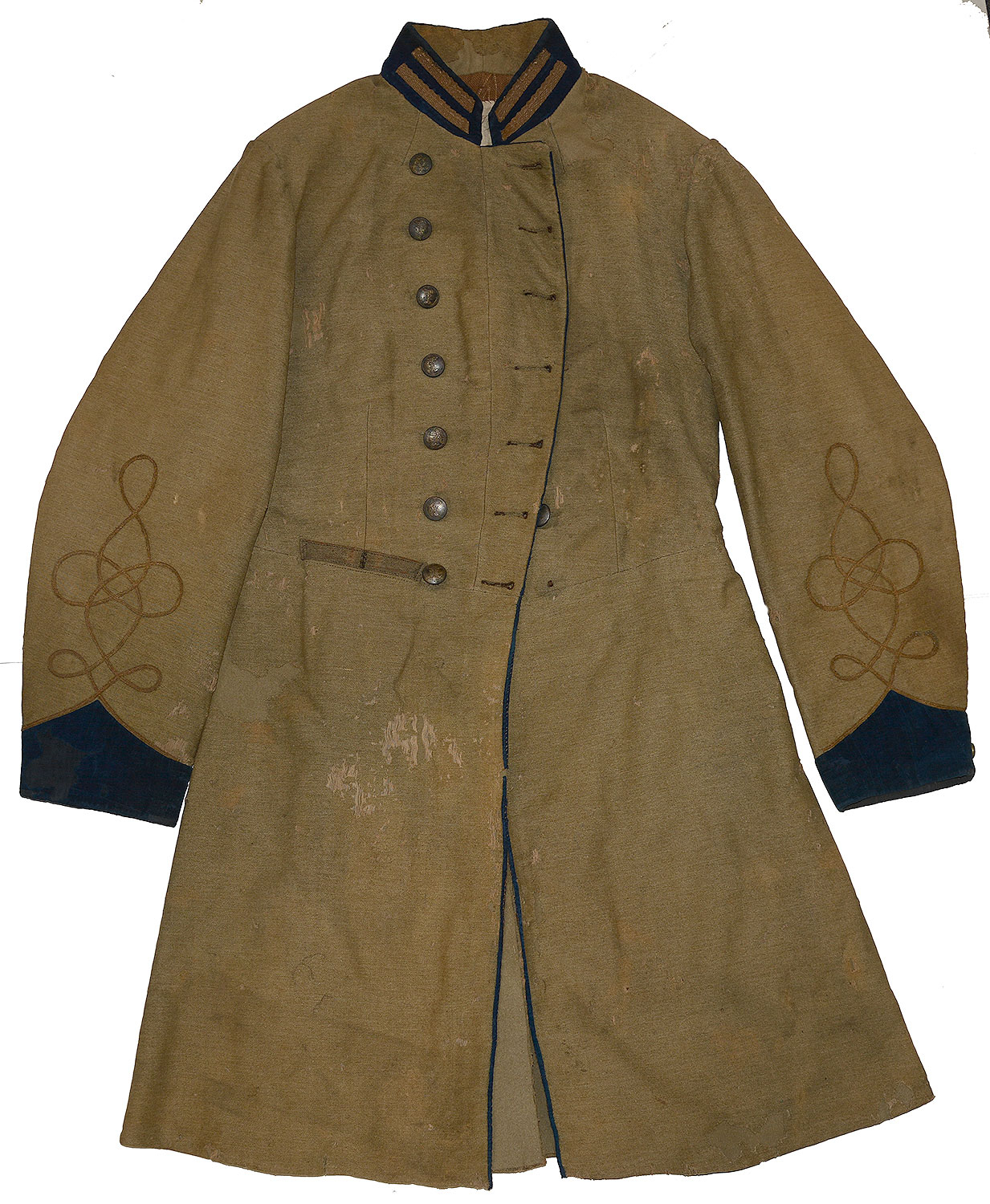
Hover to zoom

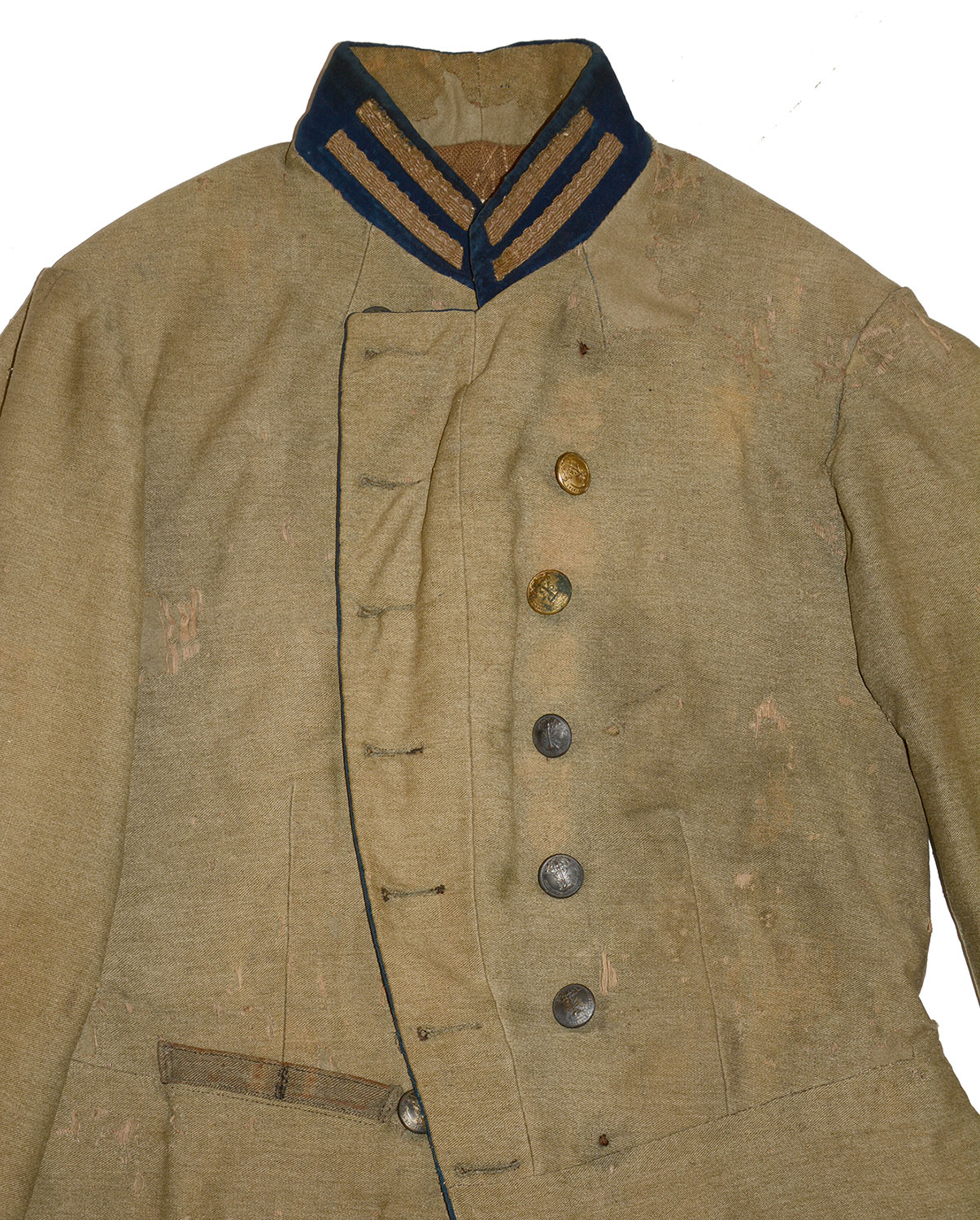
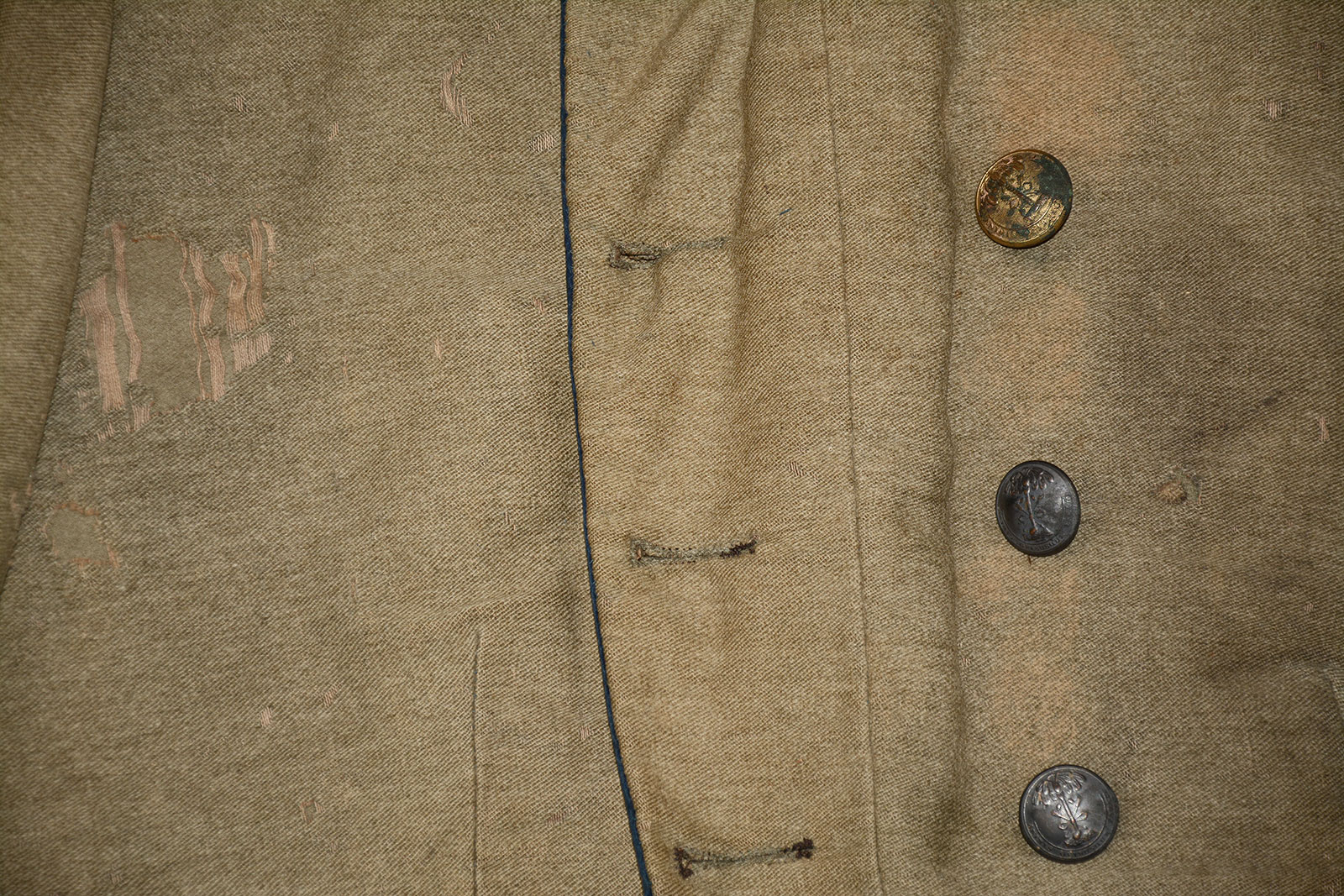

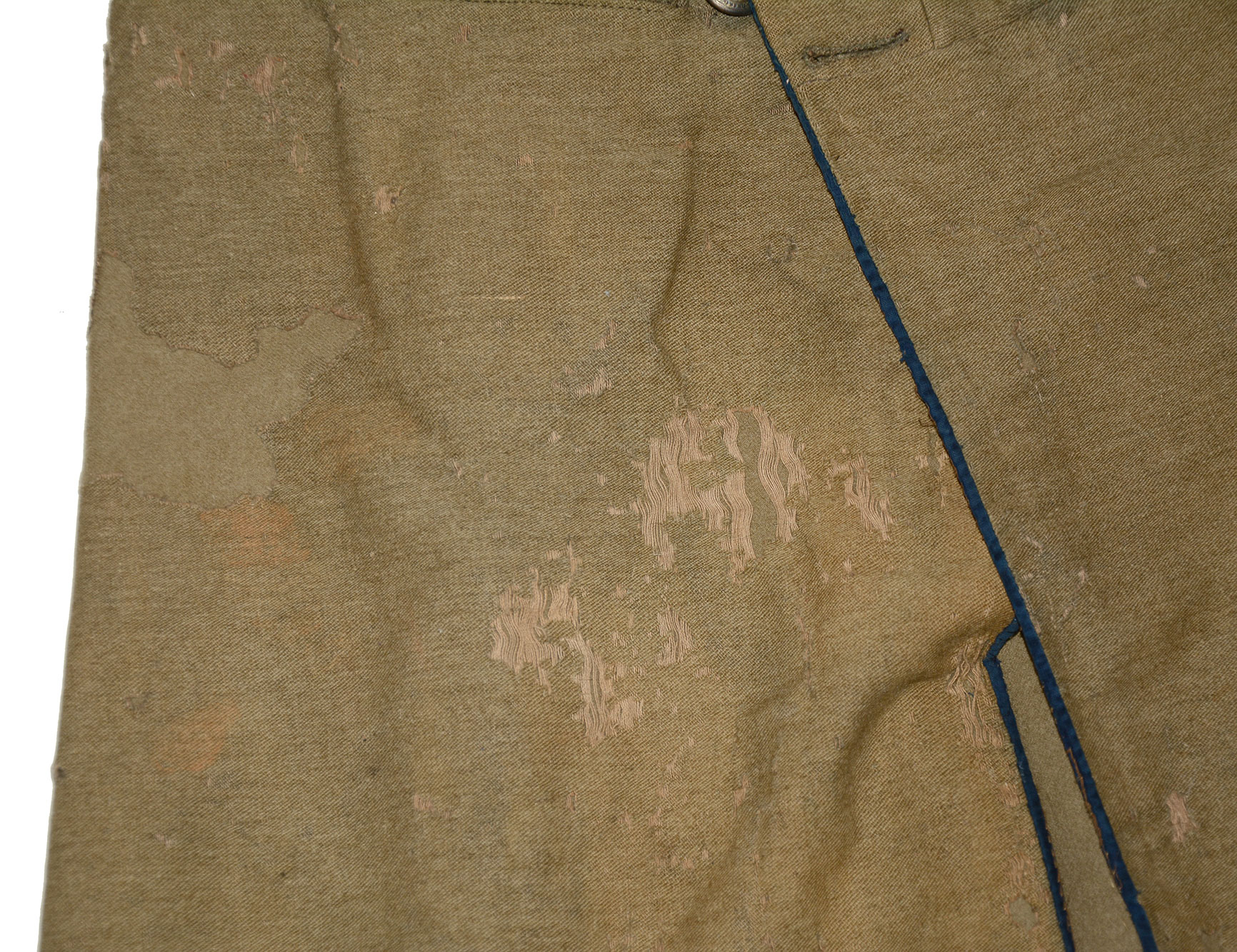
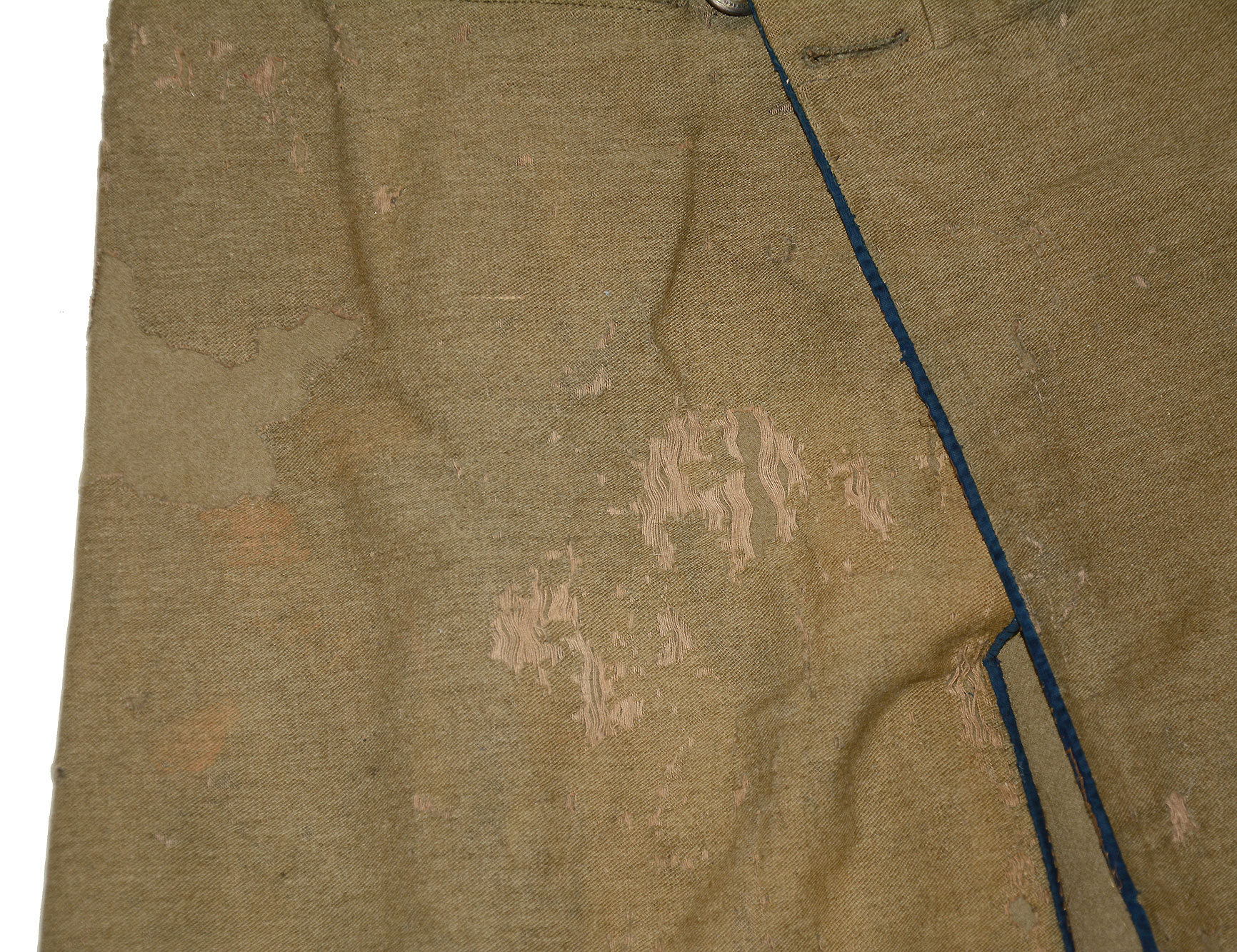
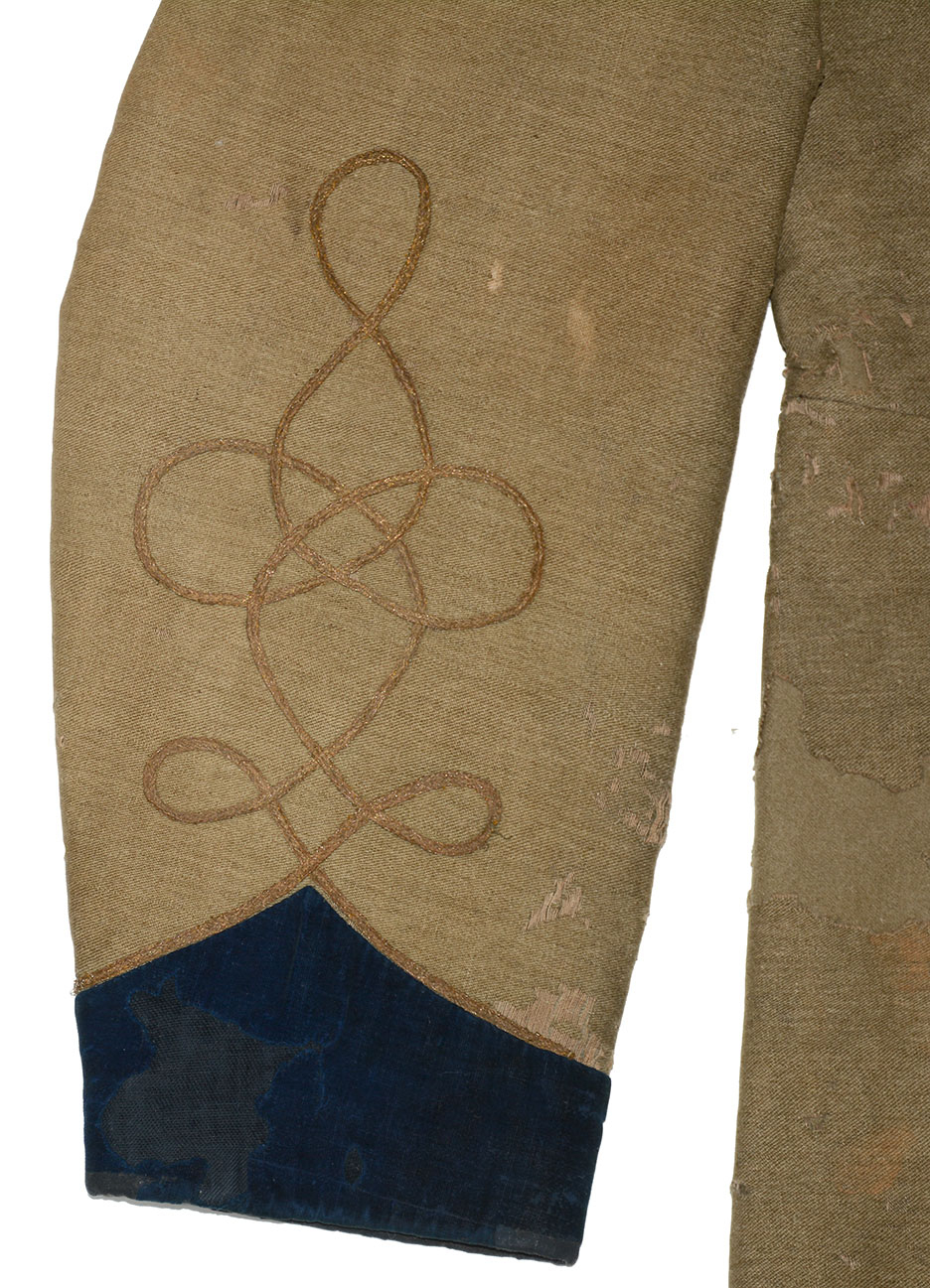
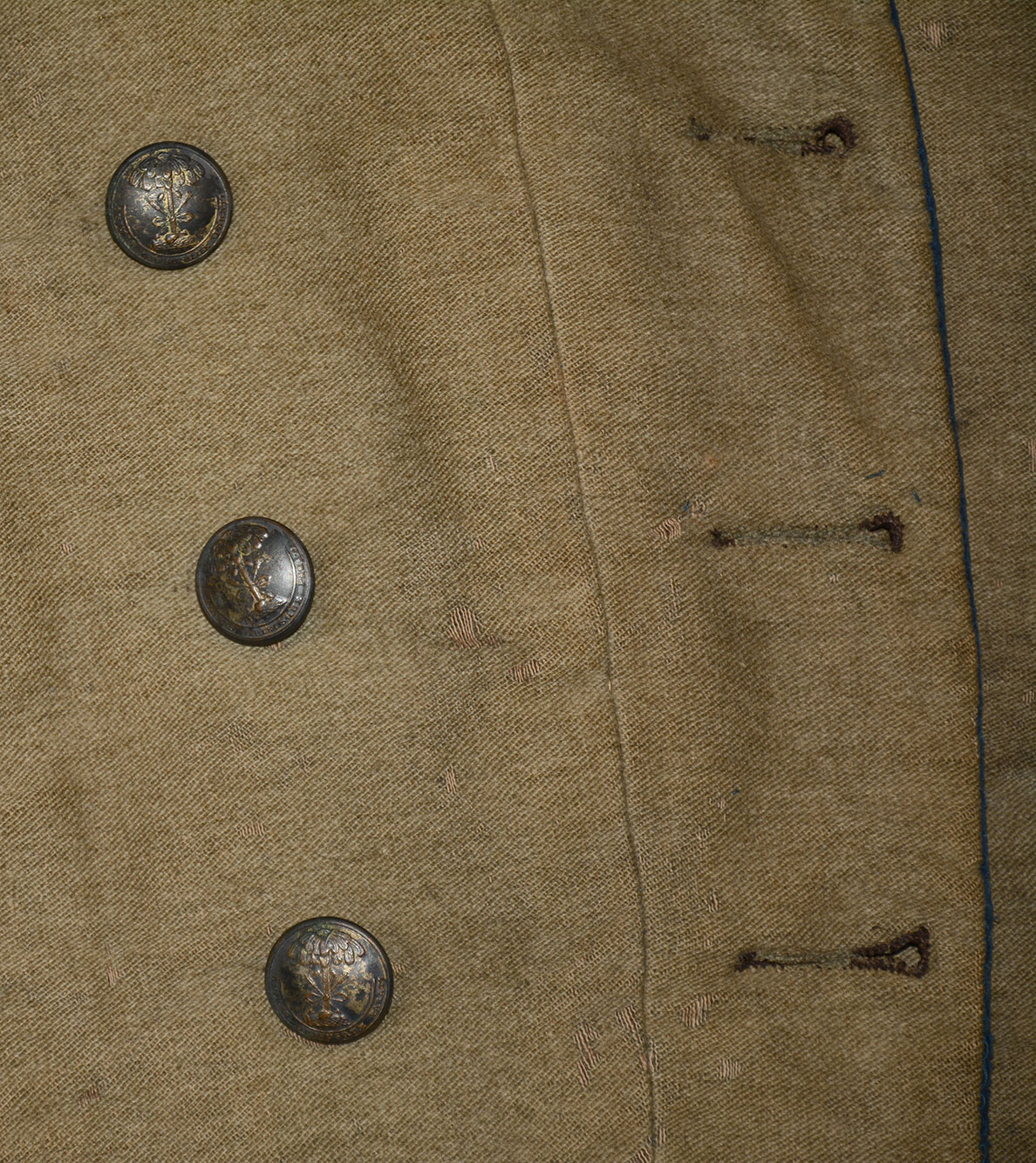
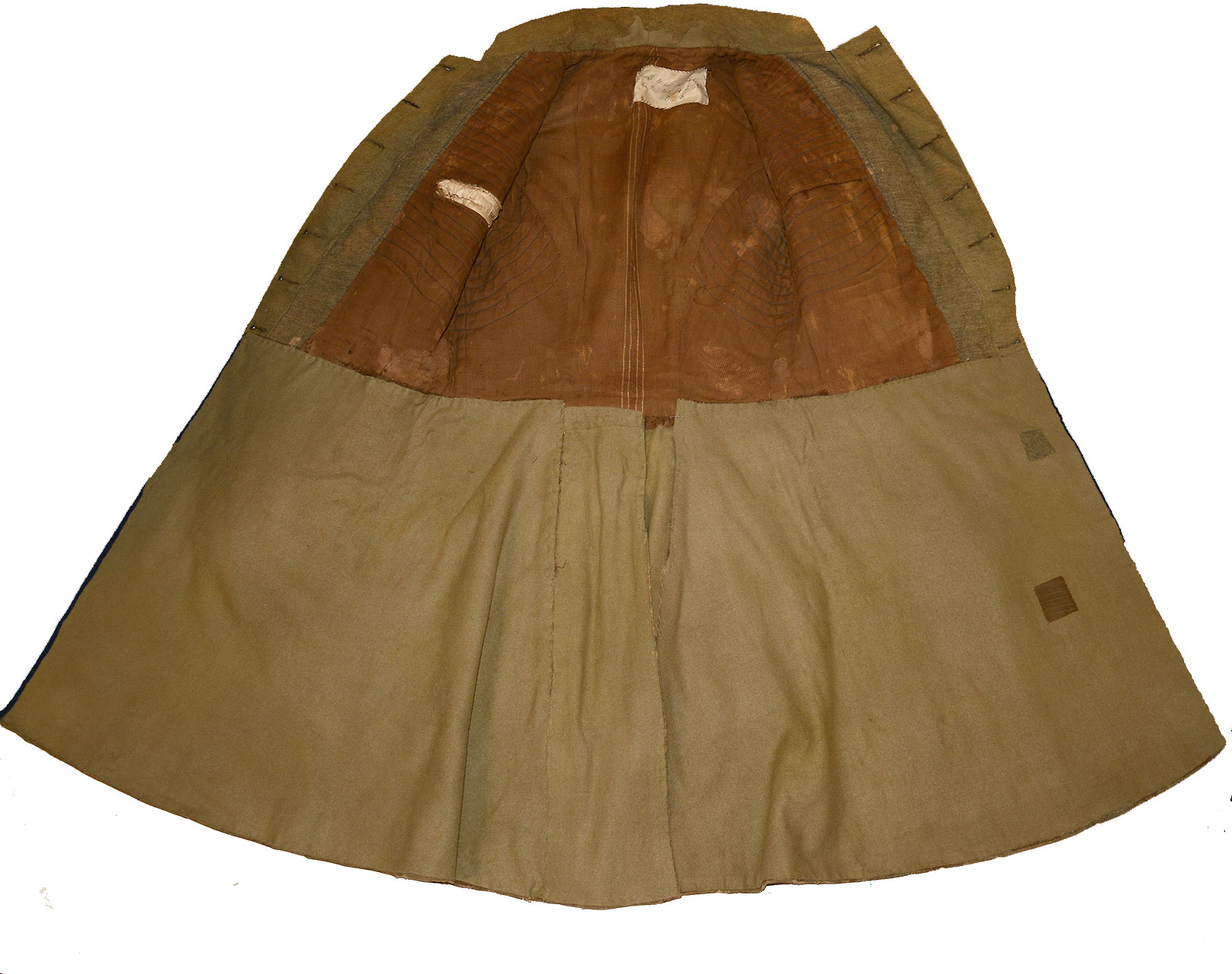

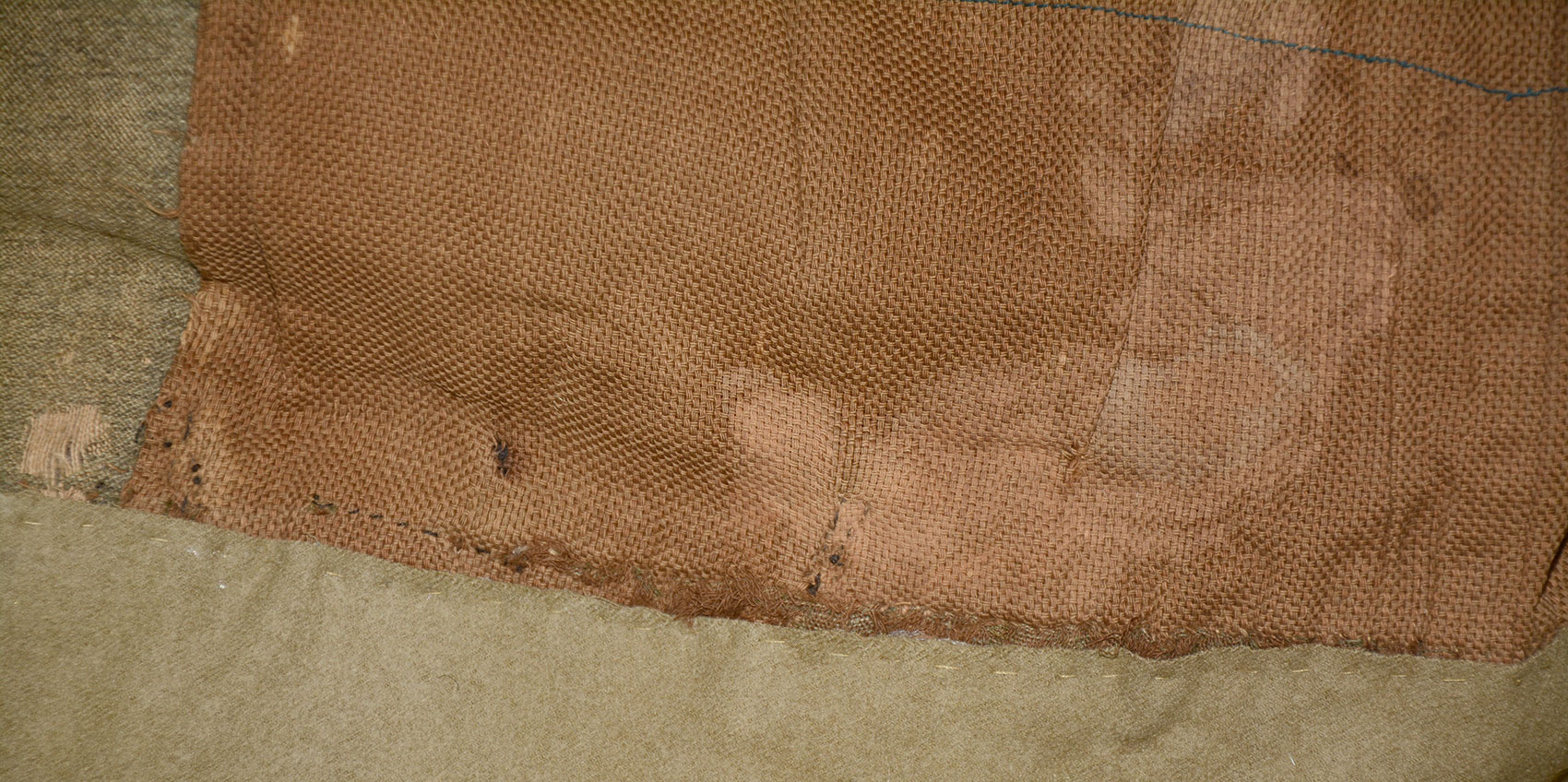

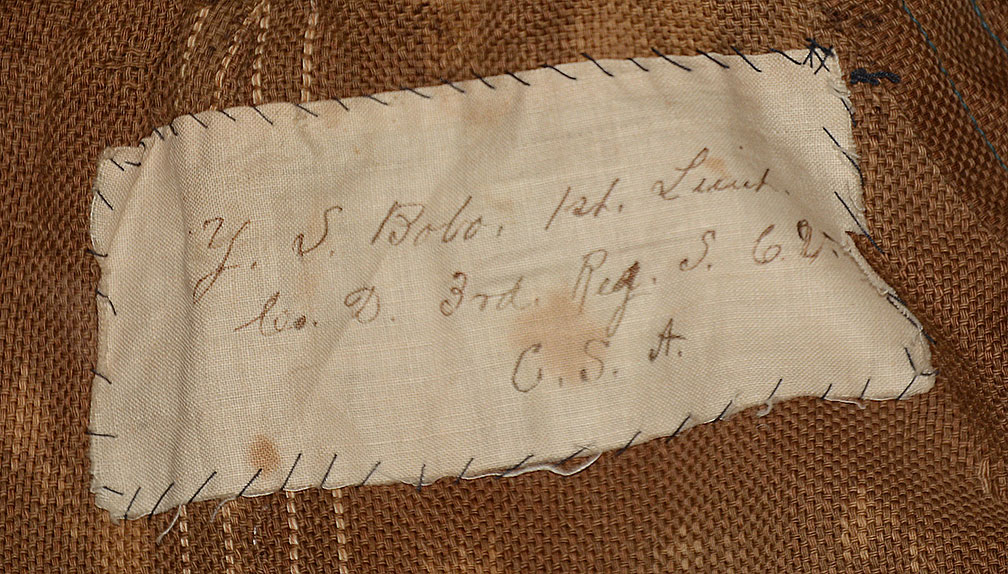
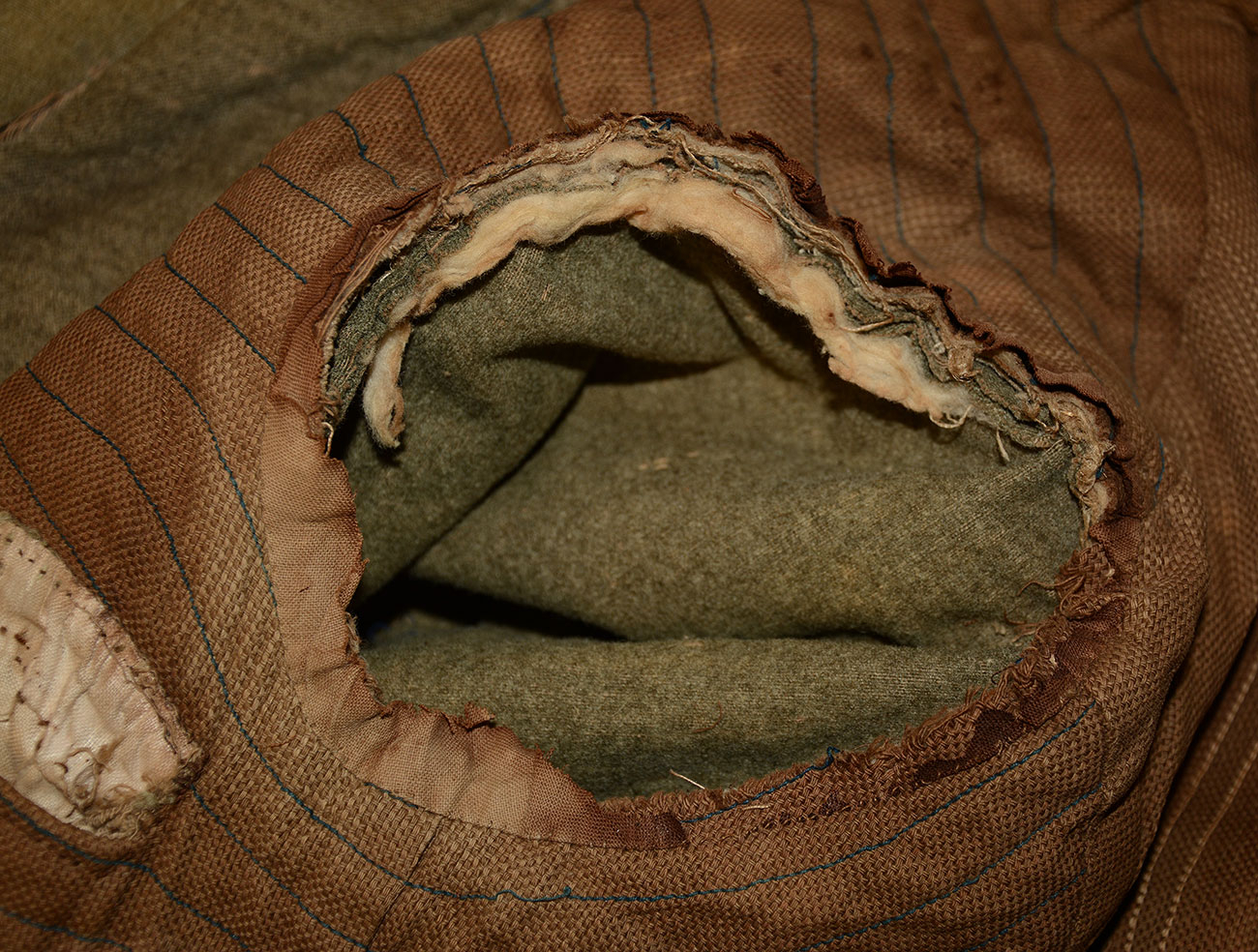
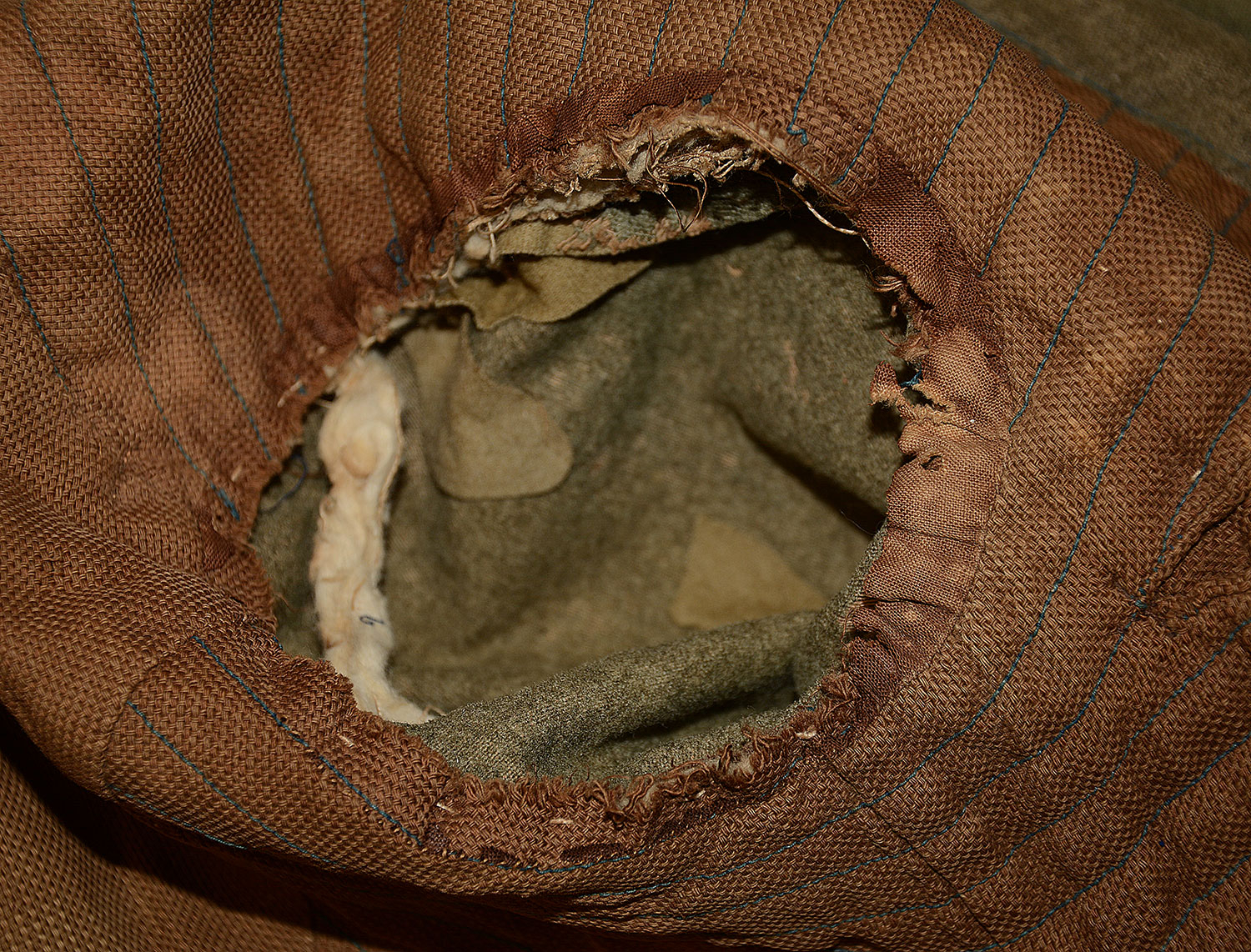
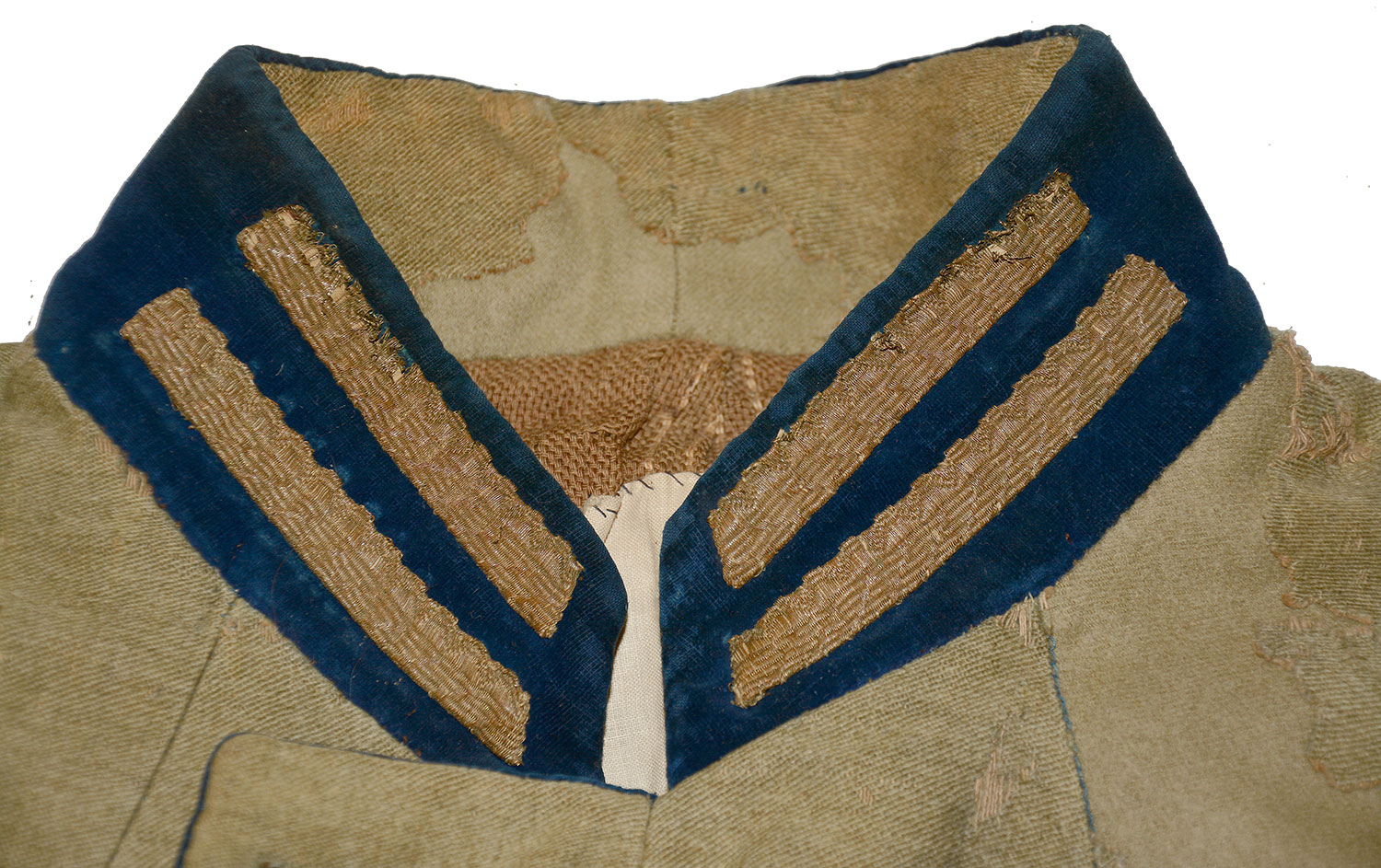
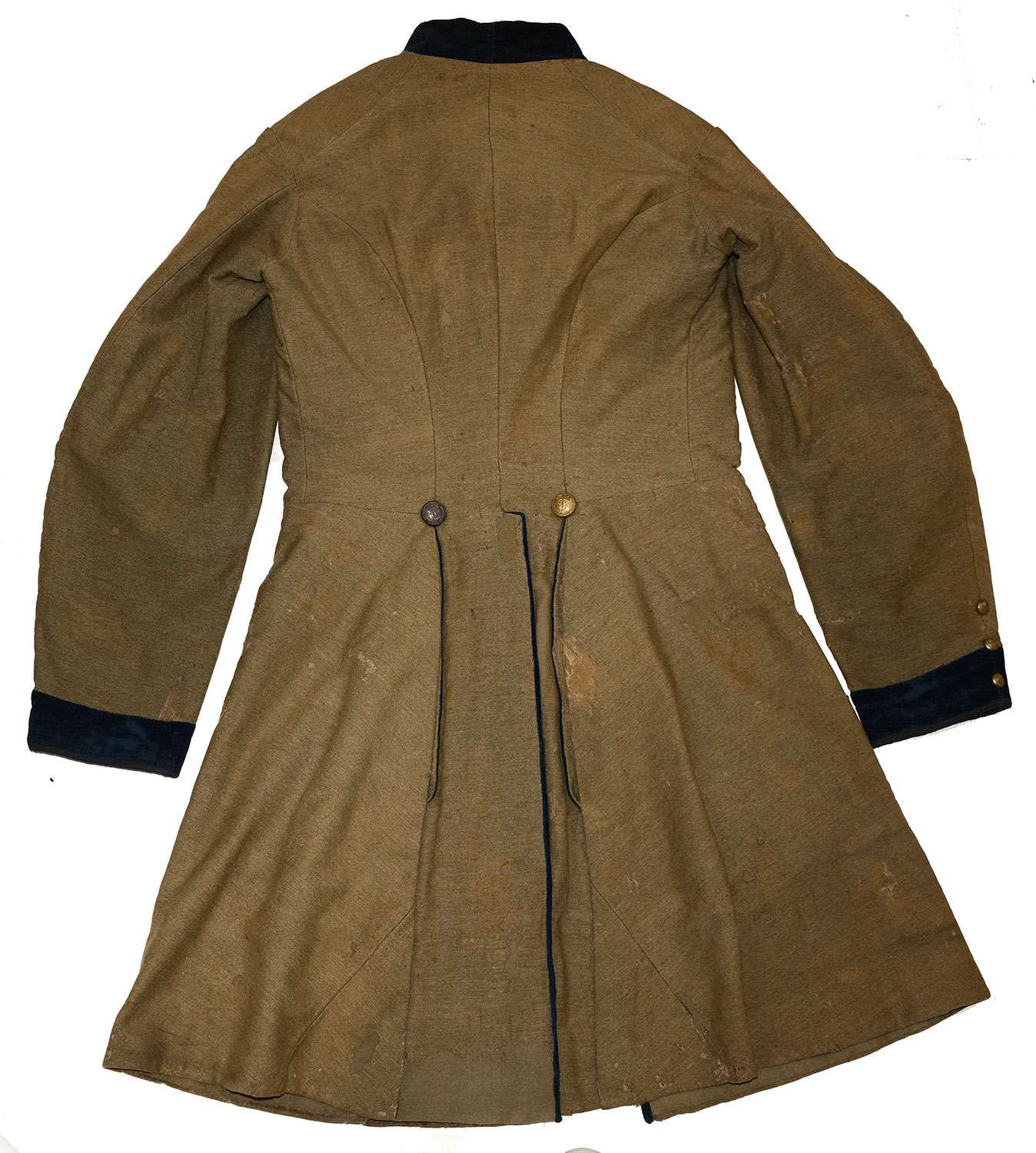
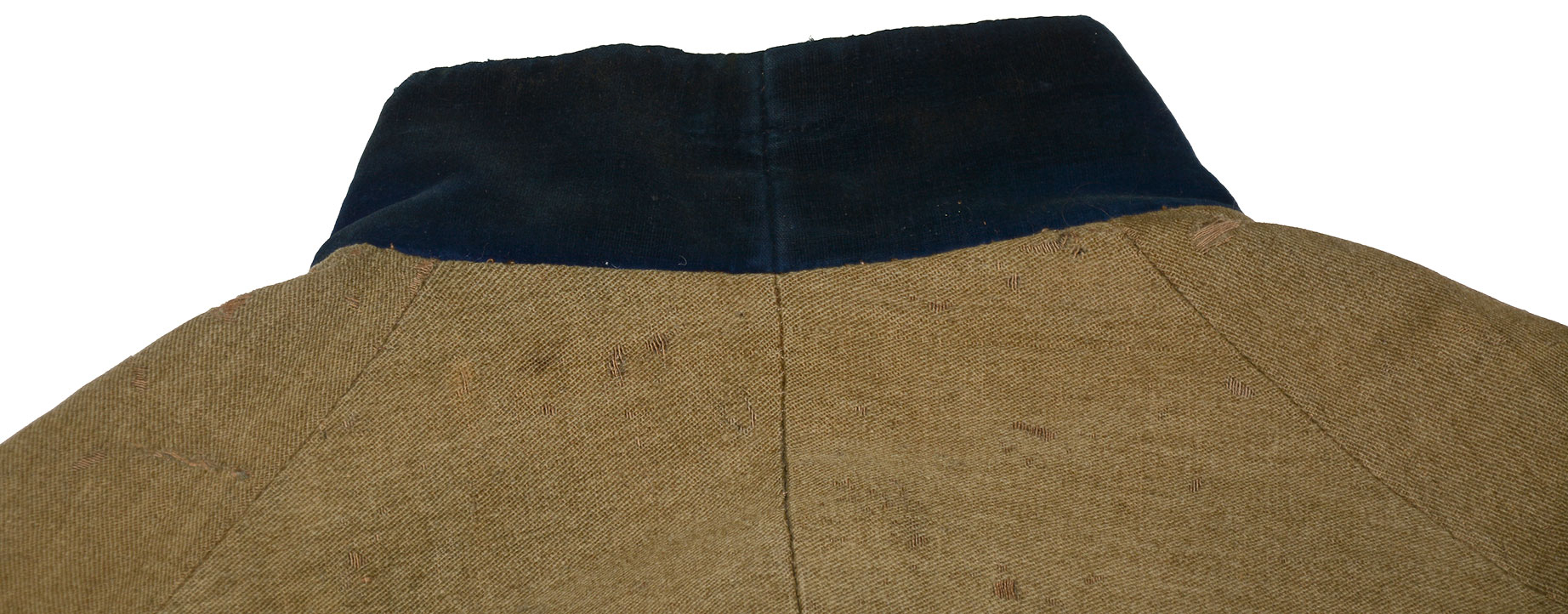
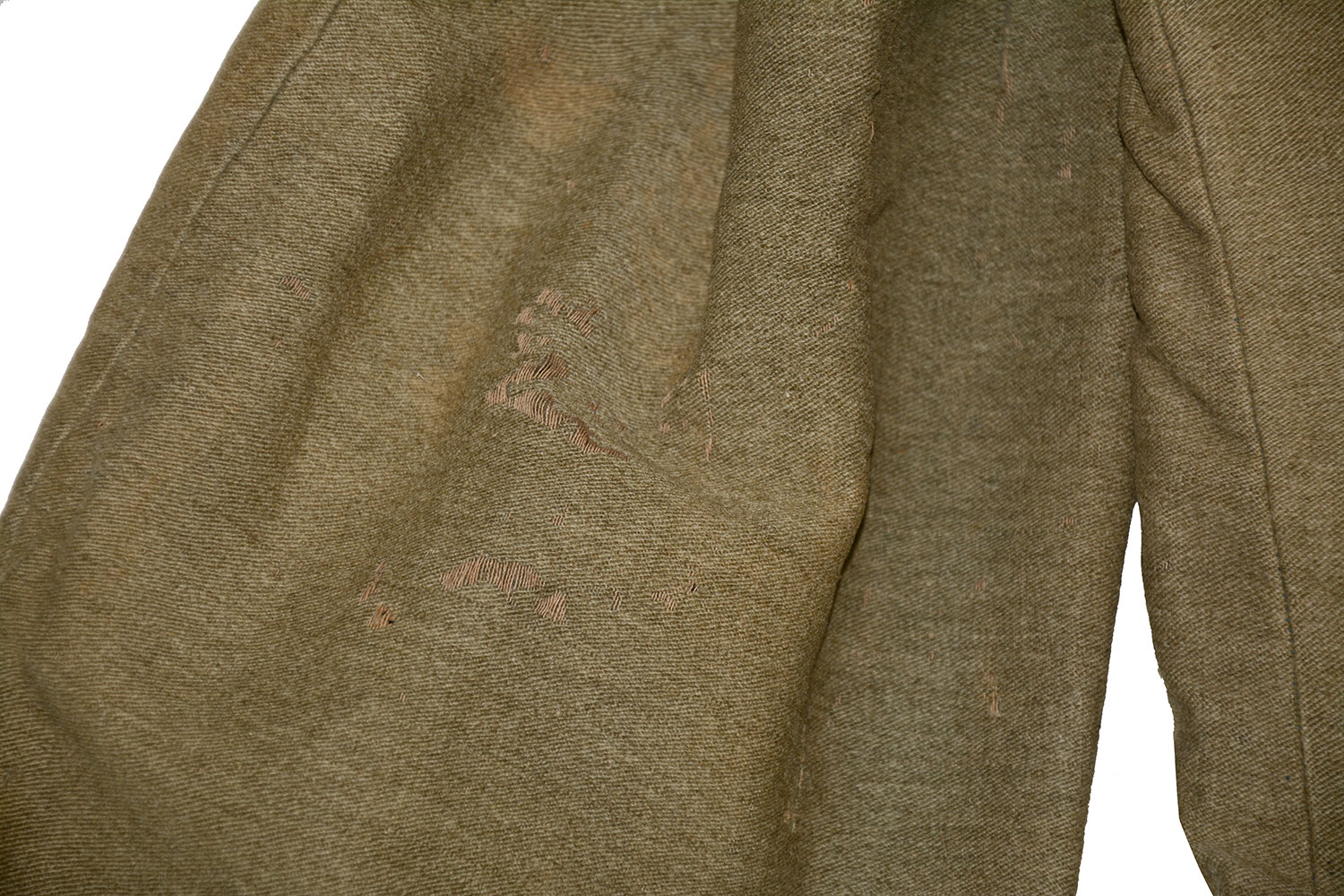
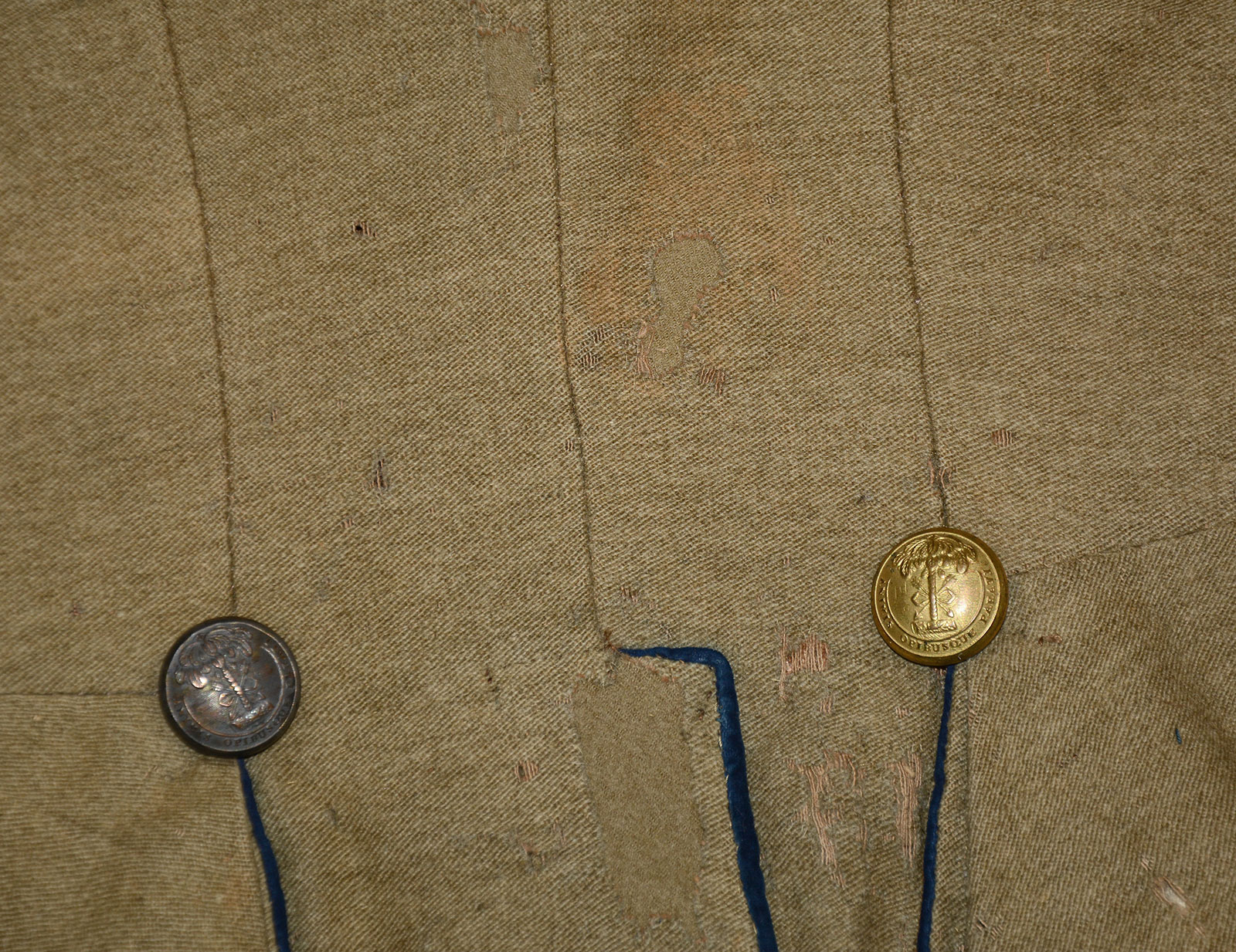
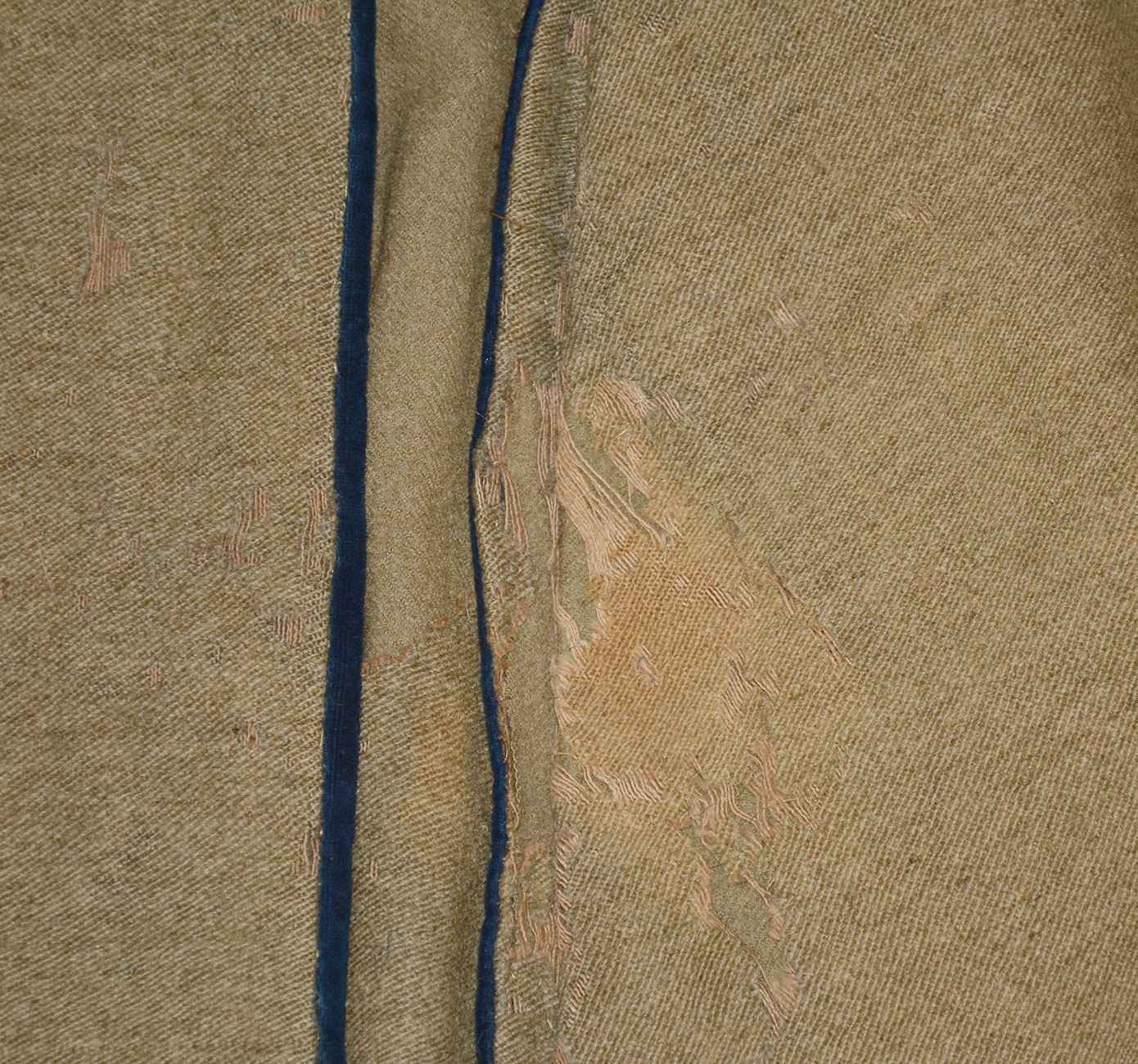
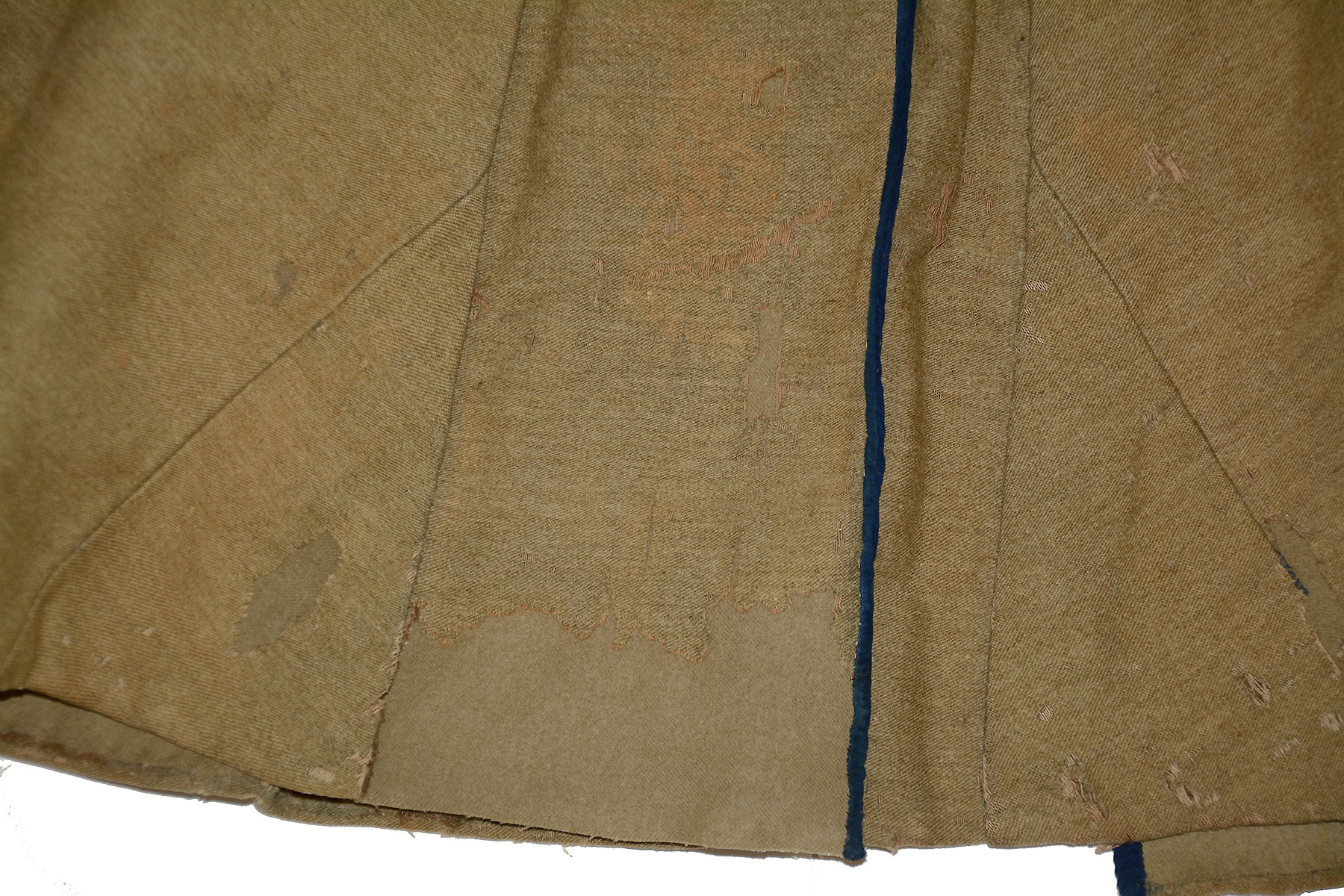
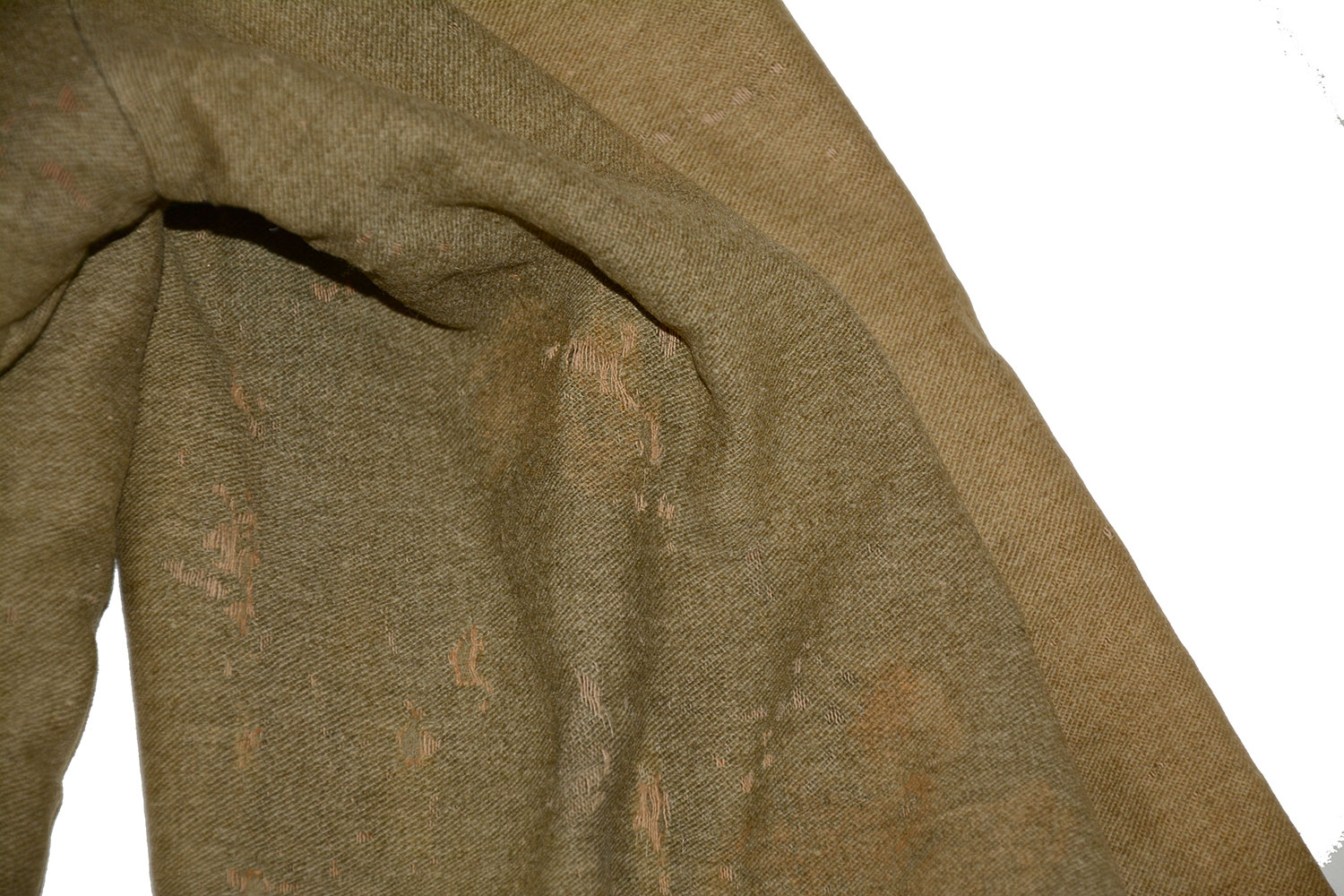
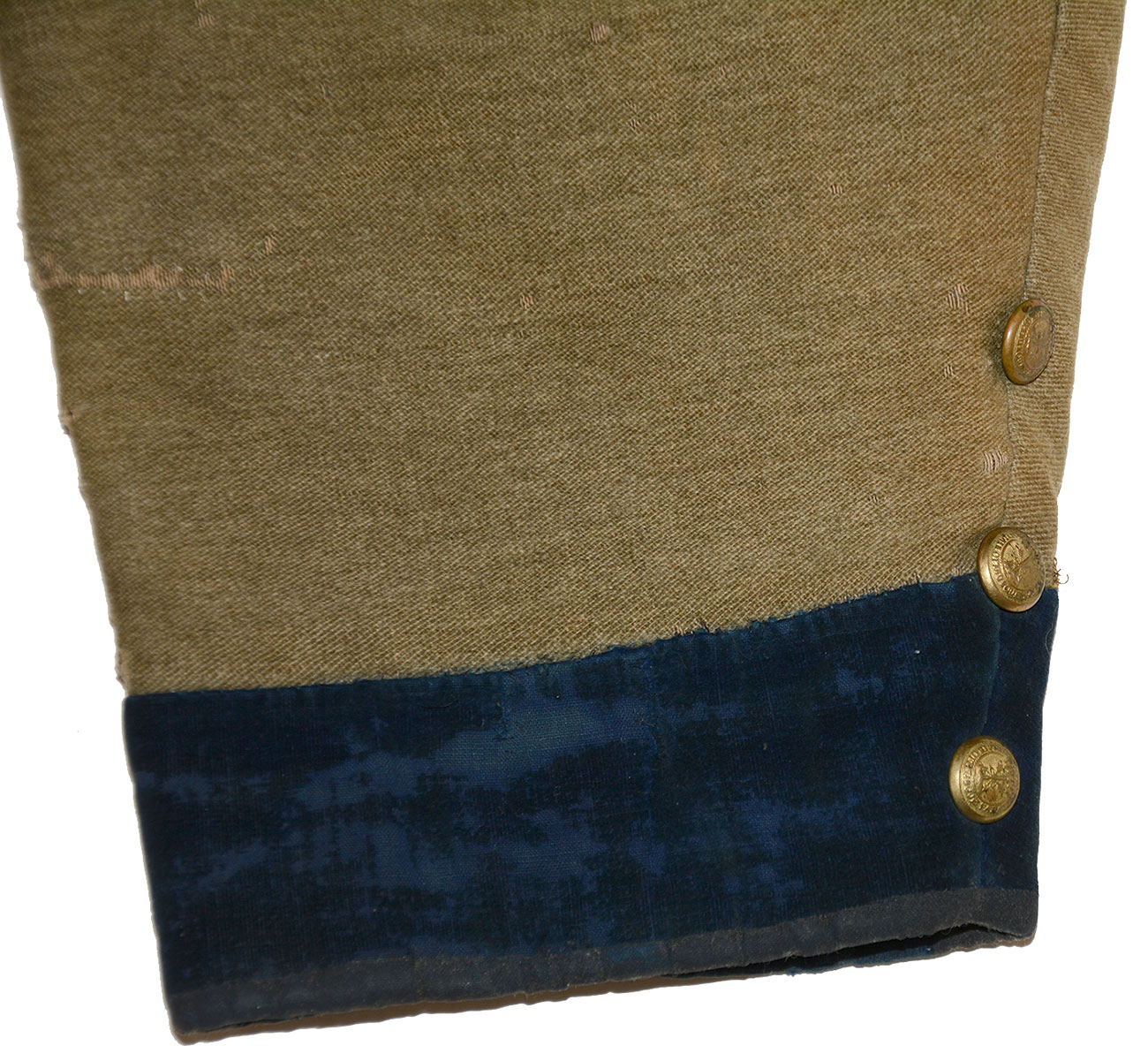
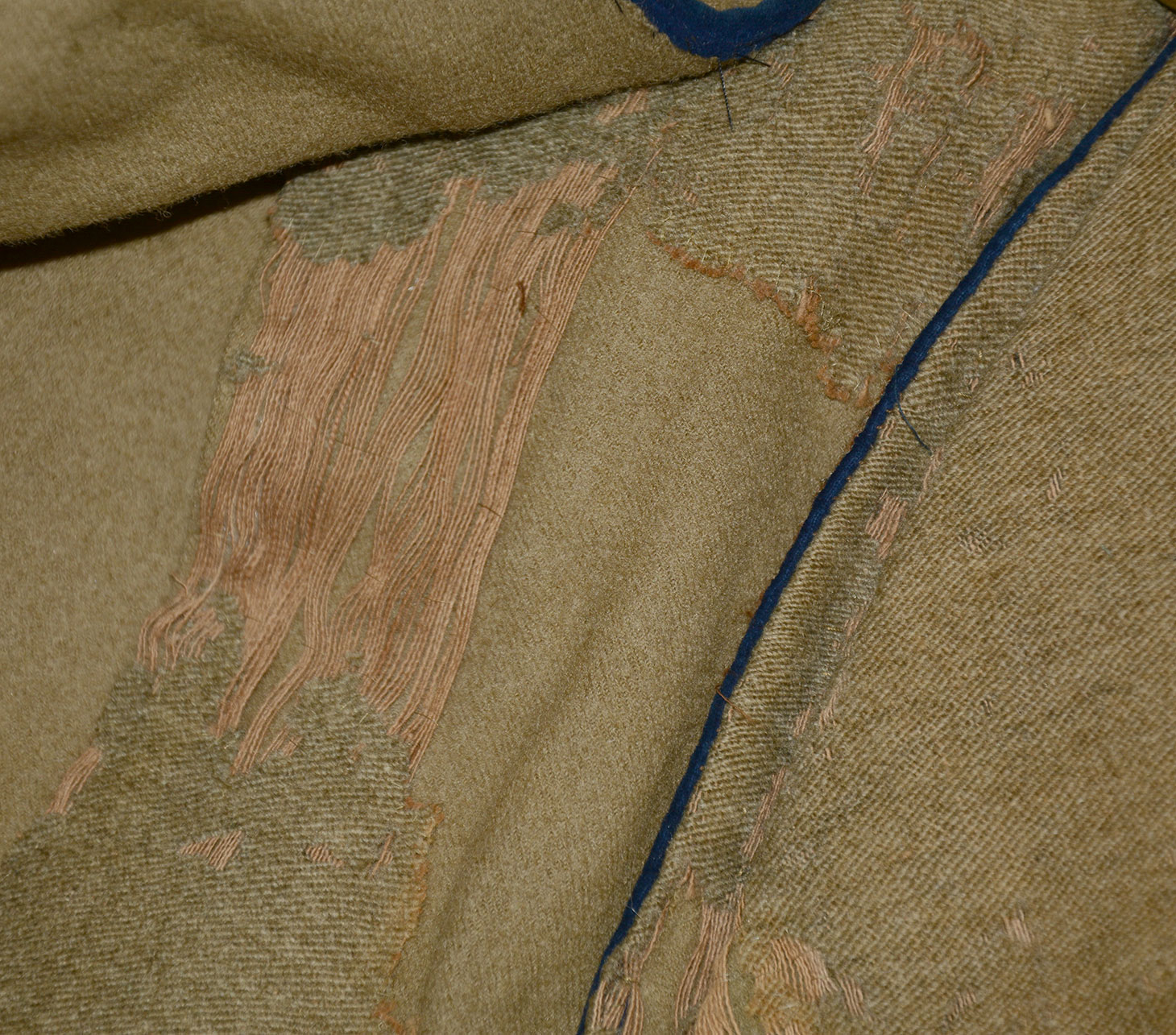
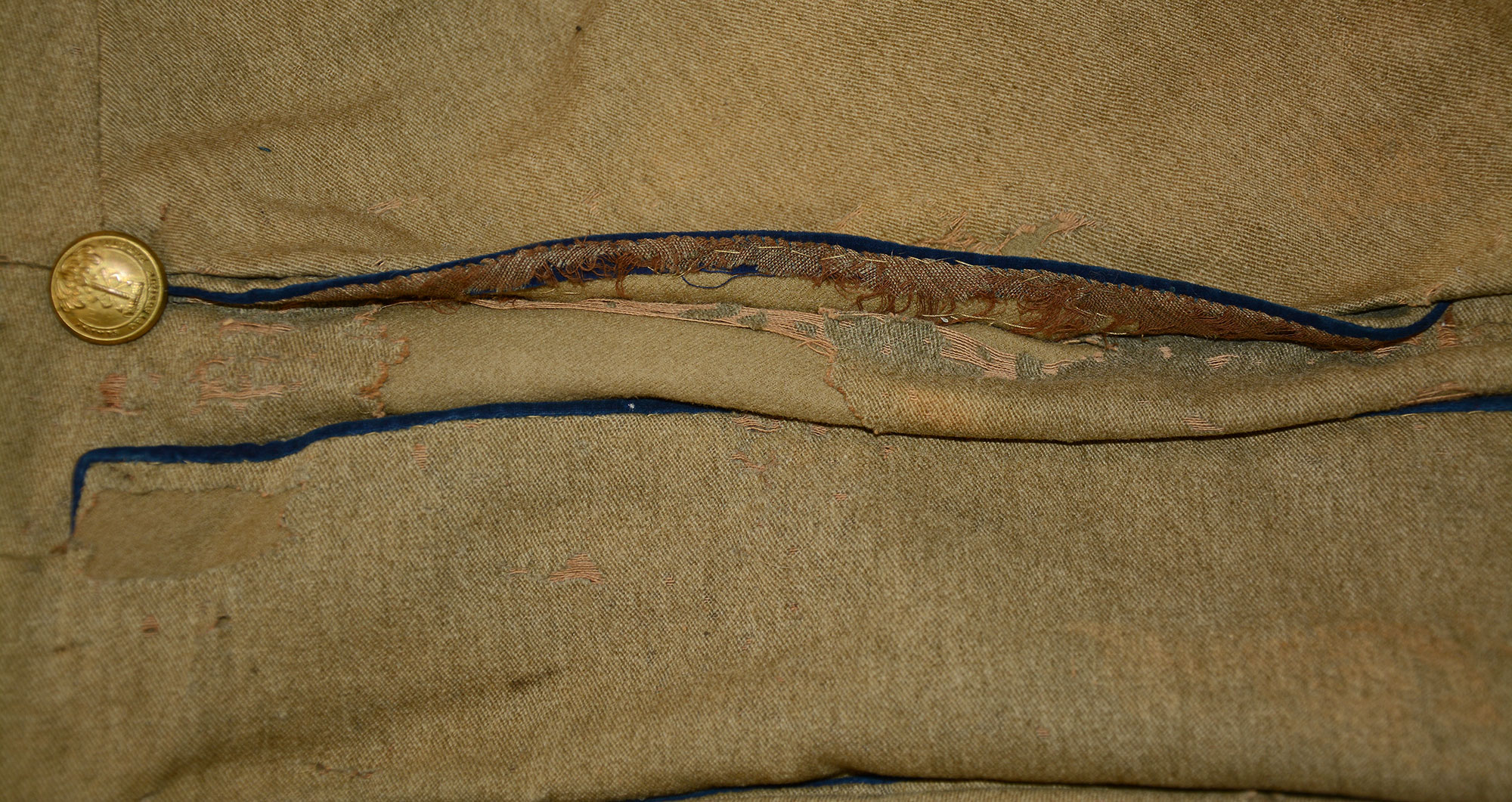
$35,000.00 SOLD
Quantity Available: None
Item Code: 1179-267
This regulation South Carolina infantry first lieutenant’s frock coat was formerly on display in the Texas Civil War Museum and is identified by a wonderful, brown ink inscription by the officer on a cloth identification label sewn inside, which matches his signature in his service records. The officer is the majestically named Young Solomon Bobo, who served in the 3rd South Carolina of Kershaw’s Brigade, first as a private and then elected by his company as First Lieutenant on May 13, 1862, when the regiment reorganized for further Confederate service. The coat has been professionally conserved, is solid, stable, and presents very well. It shows as light butternut brown, but some concealed spots and shading on the wearer’s lower left chest show as gray, indicating the unstable dye color shifted from exposure.
Collar and cuffs are a medium blue velvet retaining strong color. The edges of the lapels are piped in the same color. The collar is trimmed on each side with two strips of gold braid indicating a first lieutenant, each strip about 3/8” wide, with the upper about 3 ¼ inches long and the lower 3 ½ inches, with front edges angled to match the slope of the collar. Each cuff has an officer’s quatrefoil sleeve knot made of a single strand of 1/8” wide gold braid extending to near the elbow. The cuffs are non-functional. One retains 3 small SC buttons; the other, 1. The coat is double breasted with seven buttons in each row. All seven are in place on the wearer’s right. The top and bottom are missing on the wearer’s left. A small exterior pocket is set in the waist on the right. It was closed with a small button, now missing. The tails are piped in matching medium blue along the vent and the edges of false pockets. Two large SC buttons are on the rear waist. There were likely others on the bottom of each false pocket.
The interior is quilted in the chest and shoulders with a loose-weave brown cloth and padded for two inches between the edge of the body lining and beginning of the lapel on either side. The chest is fitted with an interior pocket on either side. The owner’s label is 2” x 4 ½”, sewn slight off the center line of the back seam. There is a simple interior pocket in each tail, lined in white muslin. The sleeves were lined in the same material, but only a small, stained portion about 1” wide remains inside the wearer’s left cuff.
All buttons are South Carolina state seals. All seven on the right lapel, three of five on the left, and one of the tail buttons are silvered, now slightly muted. The others show as muted gilt, either from rubbing and or replacement. We do not have the museum’s conservation report, but a number of wear spots or holes have been professionally backed with matching fabric, though not readily evident. The largest is about 1 ½ by 1 ½ on the right chest near the arm and another descending from the collar on the wearer’s upper left breast, about 2 inches from the collar edge and running back about 2” to the top of the shoulder and down about 1 ½ inches on the front and 3 ½ inches in an irregular line at rear, to a more or less horizontal line with some other smaller holes backed near the shoulder. Even these spots, however, blend in marvelously, do not jump out at the viewer, and serve to stabilize the garment and improve it for display.
The interior label reads, “Y.S. Bobo 1st Lieut. / Co. D 3rd Reg. S.C.V./ C.S.A.” Born August 1, 1836, he is listed in the 1860 census as age 24, living with his father and mother, both age 63. He is listed as “Solomon” and the father as “Young,” perhaps their immediate family names. The family was prominent in the area of Cross Keys, with another branch close by at Cross Anchor, and other relatives as far west as Mississippi and Louisiana. By this time, the ancestral house and plantation, after which the community was named, seems to have changed ownership, but the family remained in the area. (The house still exists and is owned by the local historical society.) Bobo enlisted at age 24 at neighboring Cross Anchor as a private on 4/14/1861 in a company commanded by Capt. T.B. Ferguson and nicknamed the “Cross Anchor Volunteers.” The company seems to have existed as early as January 1861 as part of the 45th South Carolina Militia, Lower Battalion. The 3rd SC Volunteers was one of ten volunteer regiments authorized by the state on Dec. 17, 1860, for one year’s service, accepted on March 6, 1861, and ordered to rendezvous on April 13 at Columbia. The Cross Anchor Volunteers joined it April 17, becoming Company D.
The regiment appears to have gone to Charleston soon after the firing on Fort Sumter, but by May 13 was ordered to Camp Johnson, on the Charlotte & South Carolina Railroad, at Lightwood Knot Springs, about seven miles north of Columbia, where it mustered into Confederate service for one year on June 6. They joined the Confederate forces at Manassas Junction, via Richmond, on the morning of June 23 and were assigned to Bonham’s brigade June 29. Posted near Fairfax July 1-17, they pulled back to Mitchell’s Ford on July 18 as McDowell advanced. Union forces probed the area of Mitchell’s Ford, but the regiment was not engaged then or in the main battle on July 21, McDowell choosing instead to hit the Confederate left. After the battle, they took part in the advance to Centreville and were posted in Fairfax County into the Fall.
The regiment came under Kershaw’s command in early 1862 and, numbering some 550 men, was assigned to the Peninsula as part of McLaws’ Division under Magruder. This puts them in position for Magruder’s well known theatrics that stalled McClellan and they were present, though not engaged, at the siege of Yorktown and Battle of Williamsburg in April and early May. In keeping with acts of the Confederate Congress, the regiment was reorganized for continued Confederate service in May and there was something of a housecleaning among the officers, with a younger group being elected and commissioned, including Bobo, who was elected the First Lieutenant of Company D as of May 13, 1862, thus dating his coat.
At that rank he was with the regiment, still part of Magruder’s command, as they constructed works in front of Richmond in June to hold the eastern approaches to the city while other Confederate forces massed against the Union right on the north side of the Chickahominy. Records indicate he was admitted to the General Hospital, Camp Winder, in Richmond, for dysentery on June 26. It is not clear if he returned to the regiment in time for their initiation in battle on June 29, when they helped push back the Union rearguard from Fair Oaks to Allen’s Farm, and then to Savage Station. There, in a bloody engagement, the 3rd SC advanced in the left center of Kershaw’s brigade, which aligned itself with the Richmond and York River Railroad on its left, along which rolled a Confederate railroad gun. Along with the 2nd SC, the 3rd broke through the center of the opposing Philadelphia Brigade and was then confronted by the 15th Mass and 82nd NY in fighting that brought the lines sometimes as close as five yards. They were eventually forced to withdraw after Confederate units to their right were pushed back and darkness ended the fighting with a loss to the regiment of 23 killed, 108 wounded, and 4 missing. They would be called into action again late on June 30 in the doomed assaults at Malvern Hill, but the fighting had taken a toll, the brigades of Semmes and Kershaw together fielding only some 1,513 men of the 3,500 they carried into action the day before.
Bobo received a leave a month later, on July 29, collected the pay due him the next day and headed home on a 20-day furlough. His health did not, however, improve and November 9, after several extensions of the furlough, he submitted his resignation, with medical affidavits, and he was discharged as of November 24.
It is possible, and perhaps likely, that Bobo had further service with the South Carolina militia and may have seen some duty during Sherman’s Campaigns of the Carolinas in 1865. It is an accepted tradition at Cross Keys, that Jefferson Davis, with staff and escort, paused there during his escape from Richmond.
Bobo married in February 1867 and fathered three children, two of whom, daughters, survived to adulthood. He reportedly taught school at some point and is recorded as a county commissioner in October 1872 and Chairman of the Union county commissioners in October 1873. He was a Master Mason and a member of a United Confederate Veterans camp. He was involved in some of the immediate postwar political chaos of the state before his elevation to commissioner. We find at least one arrest report, and a jail break. He died January 1, 1902, and is buried in the Padget’s Creek Baptist Church Cemetery at Cross Keys.
This is a rare and remarkable Confederate officer’s coat that shows off very well and could be the centerpiece of a South Carolina, Confederate uniform, officer, or infantry display. [sr] [ph:L]
~~~~~~~~~~~~~~~~~~~~~~~~~~~~~~~~~~~
THIS ITEM, AS WITH ALL OTHER ITEMS AVAILABLE ON OUR WEB SITE,
MAY BE PURCHASED THROUGH OUR LAYAWAY PROGRAM.
CLICK HERE FOR OUR POLICIES AND TERMS.
THANK YOU!
Inquire About RARE, REGULATION CONFEDERATE OFFICER’S FROCK COAT OF LIEUTENANT Y.S. BOBO, 3rd SOUTH CAROLINA INFANTRY, 1862
Most Popular
Historical Firearms Stolen From The National Civil War Museum In Harrisburg, Pa »
Theft From Gravesite Of Gen. John Reynolds »
Selection Of Unframed Prints By Don Troiani »
Fine Condition Brass Infantry Bugle Insignia »
Large English Bowie Knife With Sheath 1870’S – 1880’S »
Imported (Clauberg) Us Model 1860 Light Cavalry Officer's Saber »
featured item
US MARINE CORPS OFFICER’S ENGLISH MADE MAMALUKE WITH IVORY GRIP
Manufactured: England Maker: Unmarked Year: C1820-25 Model: Mamaluke Size: 35.8 inch blade, 1.21 wide Condition: Excellent+ Tri-color blade - blue, gold and "white" of flat design. Ship's Mast, American Eagle, Standing Indian figure and… (870-76). Learn More »
site search
Upcoming Events
The shop is currently closed so that we may conduct our annual inventory. We are available by phone… Learn More »


